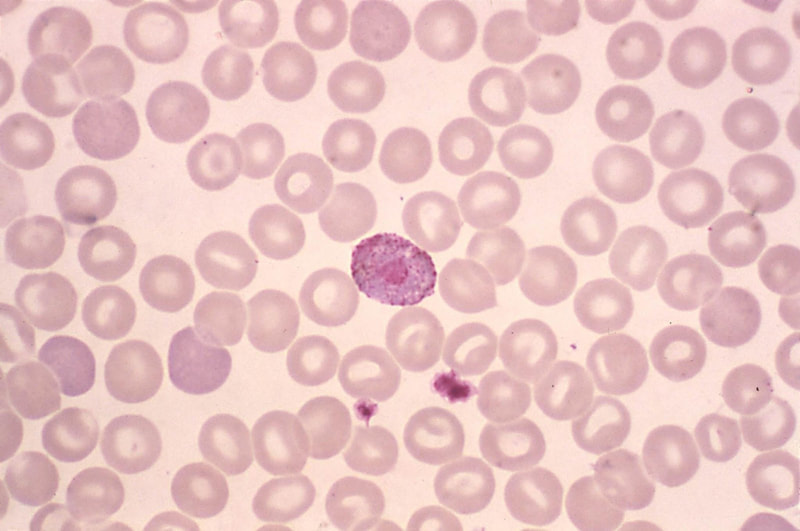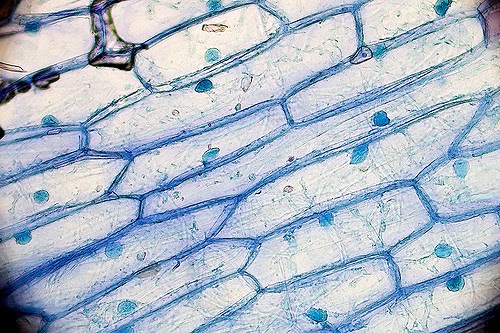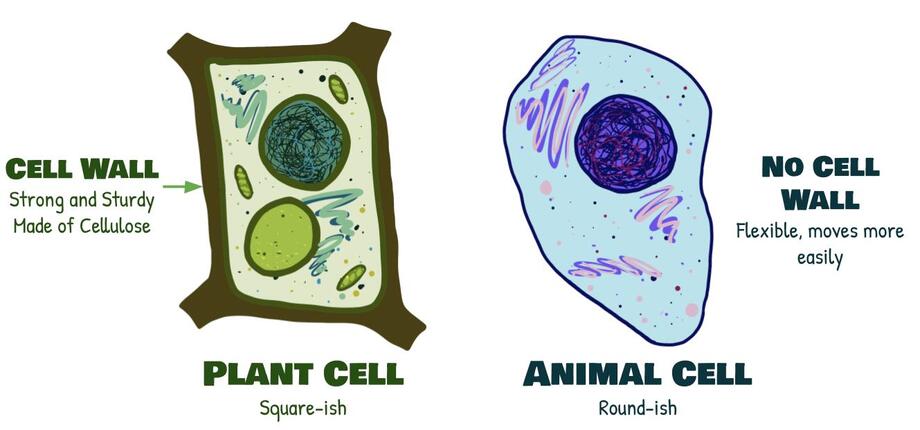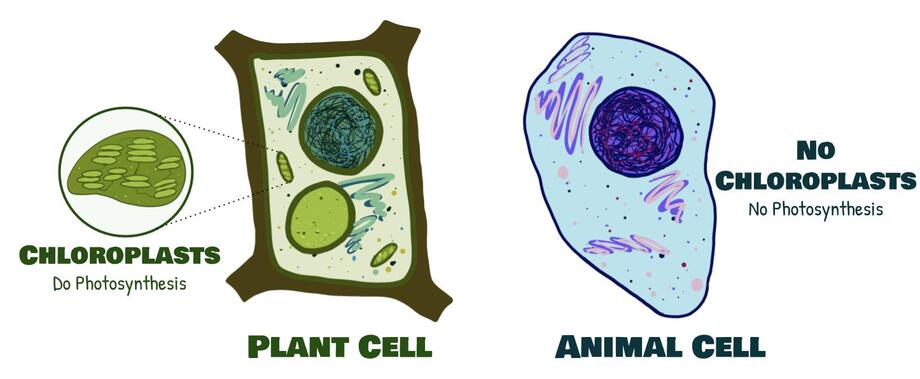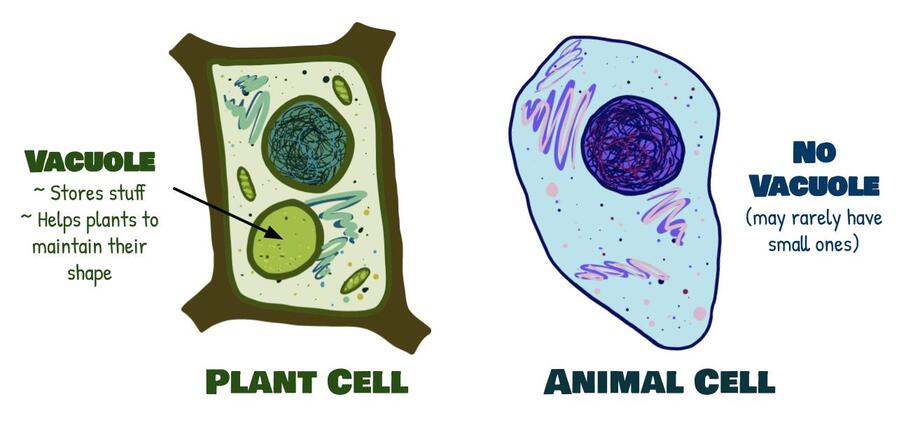Plant and Animal Cells
Consider these pictures, both of which depict cells:
|
|
Both are images of cells, but they look very different, don’t they?
The picture on the left shows blood cells from the human body, while the one on the right shows pieces of an onion’s skin. They look pretty different, and for good reason! Different cells serve different purposes—if all cells were the same, there wouldn’t be many differences between you and a blade of grass. These unique structural differences between plants and animals are what give them unique functions.
Remember:
The picture on the left shows blood cells from the human body, while the one on the right shows pieces of an onion’s skin. They look pretty different, and for good reason! Different cells serve different purposes—if all cells were the same, there wouldn’t be many differences between you and a blade of grass. These unique structural differences between plants and animals are what give them unique functions.
Remember:
Of course, every single cell type is just a little bit different from every other cell type. Otherwise, they’d just be the same cell type. But, there are some pretty broad categories that help us to narrow down the differences between different cells.
Prokaryote vs. Eukaryote
The broadest category is prokaryotic versus eukaryotic. We’ll talk much more about the differences between prokaryotic cells and eukaryotic cells later in this course. For now, know that prokaryotes are bacteria--which are tiny, simple cells--and eukaryotes are plant and animal cells (among others that we’ll talk about later). Eukaryotic cells are much larger and more complicated than prokaryotic cells. Eukaryotic cells have separate compartments inside the cell, called organelles, which have their own unique functions and their own membranes. Finally, eukaryotic cells have a nucleus, which is a large, central organelle where all the DNA is stored.
Plant vs. Animal
The rest of this lesson will focus on the main differences between plant and animal cells. The cells are different because plants and animals are different. These are a few of the key ways:
1. Plants stay in one place, so they have to be strong and sturdy so that they don’t get knocked over. By contrast, animals move around to gather food and such, so their cells have to be pretty bendy and flexible. So, plant cells have a cell wall and animal cells don’t.
The cell wall is a structure around the cell that provides strength and stability, but at the cost of mobility (moving around). This is perfect for plants and bad for animals. It is made of cellulose. Remember from biochemistry that cellulose is a polysaccharide that is very strong and sturdy. To plants, it is essential for holding their shape. To animals, it is dietary fiber. The more cellulose a plant has, the stronger and woodier it is.
The cell wall also forms in a roughly square-ish shape. So, plant cells are square-ish and animal cells are round-ish. Look back at the onion cells and blood cells. See how the onion cells are square-ish and the blood cells are round-ish? If you were paying really close attention when we talked about microscopy, you’ll have noticed that all of the plant cells I showed you (the leaf and the onion) were square-ish and all of the animal cells (the blood cells and the skin cells) were round-ish. Nothing is really perfectly square or perfectly round, and cells still have specialized shapes for their specialized functions, but all plant cells are square-ish and animal cells are round-ish.
1. Plants stay in one place, so they have to be strong and sturdy so that they don’t get knocked over. By contrast, animals move around to gather food and such, so their cells have to be pretty bendy and flexible. So, plant cells have a cell wall and animal cells don’t.
The cell wall is a structure around the cell that provides strength and stability, but at the cost of mobility (moving around). This is perfect for plants and bad for animals. It is made of cellulose. Remember from biochemistry that cellulose is a polysaccharide that is very strong and sturdy. To plants, it is essential for holding their shape. To animals, it is dietary fiber. The more cellulose a plant has, the stronger and woodier it is.
The cell wall also forms in a roughly square-ish shape. So, plant cells are square-ish and animal cells are round-ish. Look back at the onion cells and blood cells. See how the onion cells are square-ish and the blood cells are round-ish? If you were paying really close attention when we talked about microscopy, you’ll have noticed that all of the plant cells I showed you (the leaf and the onion) were square-ish and all of the animal cells (the blood cells and the skin cells) were round-ish. Nothing is really perfectly square or perfectly round, and cells still have specialized shapes for their specialized functions, but all plant cells are square-ish and animal cells are round-ish.
2. Plants do photosynthesis. Animals do not. In order to do photosynthesis, plants use a specialized organelle (a small compartment with a specialized function inside of a cell) called a chloroplast. We’ll talk more about chloroplasts when we talk about photosynthesis. For now, just keep in mind that plants have chloroplasts and animals don’t.
3. Plant cells have large, central vacuoles, and animal cells don’t. Animal cells sometimes have small vacuoles. In plants, they are almost always present and can sometimes take up most of the volume of the cell. Vacuoles are pretty broadly defined as “fluid-filled sacs”. They are used to help plants quickly adjust their size and turgor pressure (outward pressure on the cell wall, due to water), which keeps the plants from going limp when their water levels change slightly. This is especially important for plants because, unlike animals, they can’t move around to get more water (and they don’t have the same mechanisms that animals have to store water and regulate water levels, like a stomach or kidneys), so their water levels fluctuate a lot more than animals’ do. Vacuoles are also used to store things plants want (like nutrients and water) or to isolate things plants don’t want (such as toxins or waste products). It’s basically an all-purpose storage tank.
Structure Creates Function
All of the differences between plant and animal cell structure can be explained by their differences in function. Plants need stability while animals need mobility, so only plants have a cell wall. Plants do photosynthesis, so they have chloroplasts. Lastly, plants need a way to maintain their shape with fluctuating water levels, because they can’t move around to get water, so they have vacuoles. Structure leads to function, so differences in structure can be explained by differences in function. Plants and animals have different functions, so plant and animal cells have different structures.
(Structure creates function. Structure creates function. Structure creates function. Hey, do you think it’s important that structure creates function?)
(Structure creates function. Structure creates function. Structure creates function. Hey, do you think it’s important that structure creates function?)
Summary
You should understand:
- That prokaryotic cells are small and simple, while eukaryotic cells are larger and more complex.
- That plant cells and animal cells have several structural differences that are related to their function:
- Plant cells have a cell wall and animal cells don’t. This makes them sturdy, but at the cost of moving around. It also makes plant cells square-ish.
- Plant cells have chloroplasts and animal cells don’t. These allow them to do photosynthesis.
- Plant cells have a vacuole and animal cells don’t. Vacuoles allow for storage of, for example, starch (food for winter) and pigments. They also help plant cells maintain their shape by adjusting water pressure.
- Plant cells have a cell wall and animal cells don’t. This makes them sturdy, but at the cost of moving around. It also makes plant cells square-ish.
- That structure creates function.
Learning Activity
Content contributors: Emma Moulton and Emily Zhang
